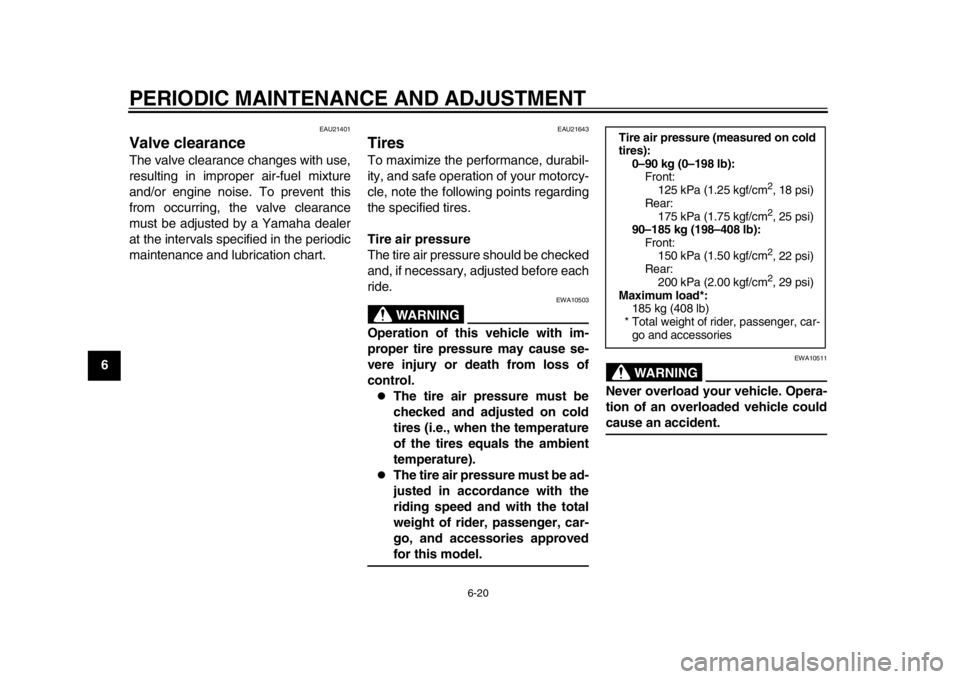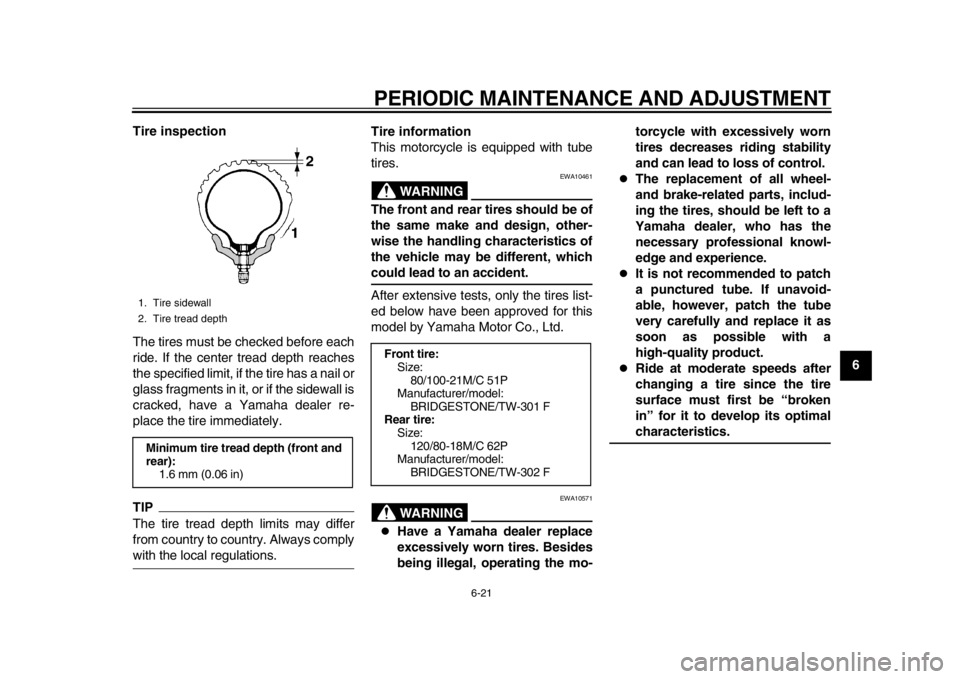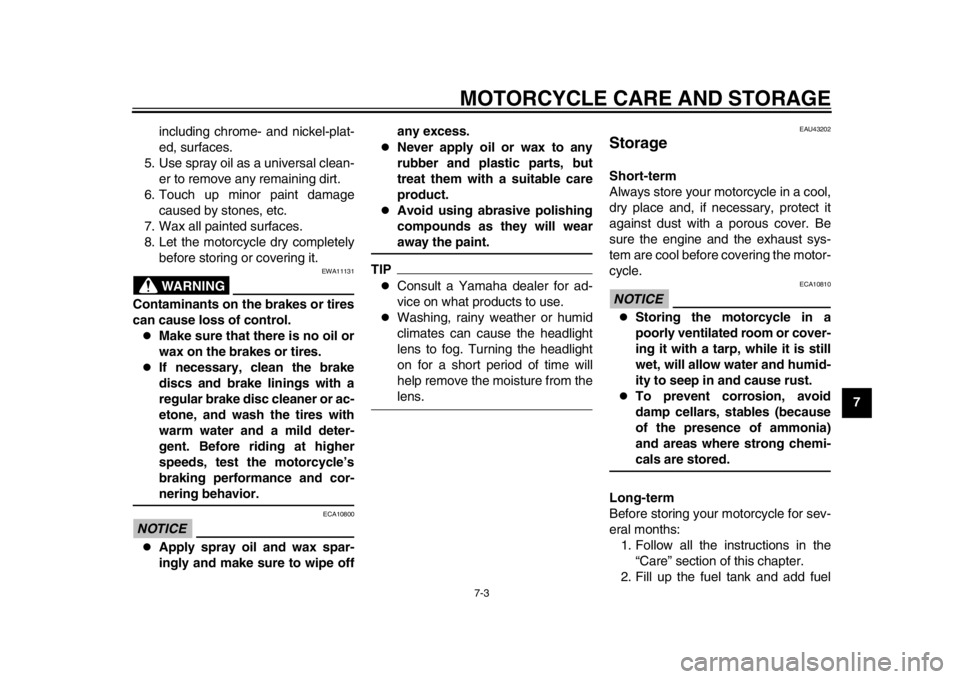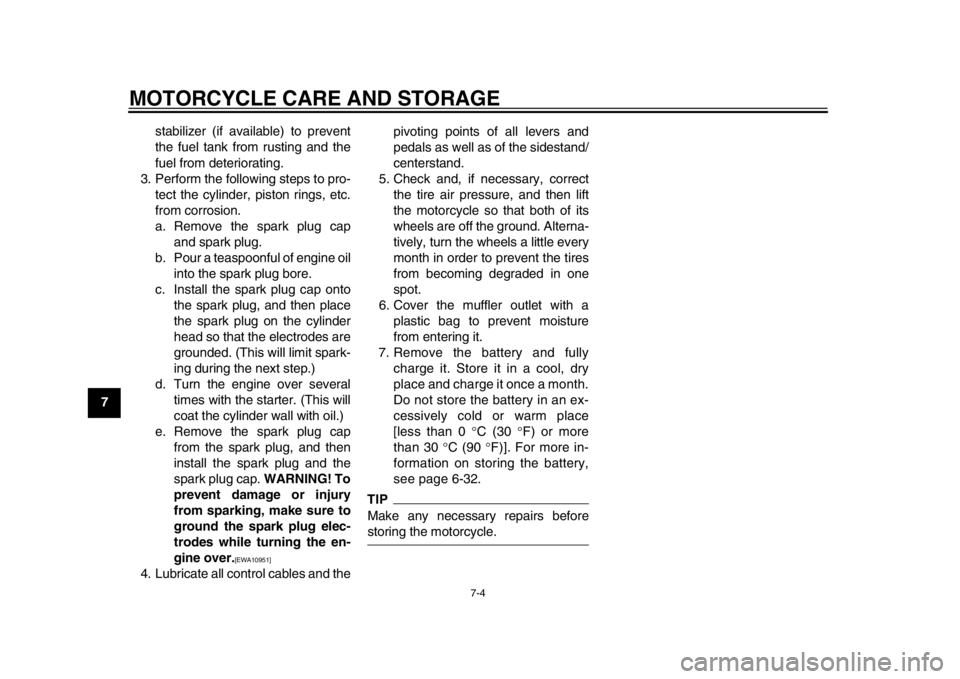tires YAMAHA WR 250R 2012 Owners Manual
[x] Cancel search | Manufacturer: YAMAHA, Model Year: 2012, Model line: WR 250R, Model: YAMAHA WR 250R 2012Pages: 98, PDF Size: 2.57 MB
Page 6 of 98

TABLE OF CONTENTSSAFETY INFORMATION .................. 1-1
DESCRIPTION .................................. 2-1
Left view .......................................... 2-1
Right view ........................................ 2-2
Controls and instrument s................. 2-3
INSTRUMENT AND CONTROL
FUNCTIONS ....................................... 3-1
Main switch/steering lock ................ 3-1
Indicator lights and warning
lights ............................................ 3-2
Multi-function display ...................... 3-3
Handlebar switches ........................ 3-8
Clutch lever ..................................... 3-9
Shift pedal ...... ............................. .. 3-10
Brake lever ................................... 3-10
Brake pedal .................................. 3-10
Fuel tank cap ................................ 3-11
Fuel ............................................... 3-11
Catalytic converter ........................ 3-13
Seat .............................................. 3-13
Helmet holder ............................... 3-14
Adjusting the front fork .................. 3-14
Front fork bleeding ........................ 3-16
Adjusting the shock absorber assembly ................................... 3-17
EXUP system ............................... 3-18
Sidestand ...................................... 3-19
Ignition circuit cut-off system ........ 3-19 FOR YOUR SAFETY
–
PRE-OPERATION CHECKS ............. 4-1
OPERATION AND IMPORTANT
RIDING POINTS ................................. 5-1
Starting the engine ......................... 5-1
Shifting ........................................... 5-2
Tips for reducing fuel consumption ............................... 5-3
Engine break-in .............................. 5-3
Parking ........................................... 5-4
PERIODIC MAINTENANCE AND
ADJUSTMENT ................................... 6-1
Owner’s tool kit ............................... 6-2
Periodic maintenance chart for the emission contro l system ....... 6-3
General maintenance and lubrication chart .......................... 6-4
Removing and installing panels ..... 6-8
Checking the spark plug ............... 6-11
Engine oil and oil filter element .... 6-12
Coolant ......................................... 6-14
Cleaning the air filter element and check hose ......................... 6-17
Adjusting the engine idling speed ........................................ 6-19
Checking the throttle grip free
play ........................................... 6-19
Valve clearance ............................ 6-20
Tires ............................................. 6-20 Spoke wheels ............................... 6-22
Adjusting the clutch lever free
play ............................................ 6-22
Adjusting the brake lever free play ............................................ 6-23
Checking the shift pedal ............... 6-24
Brake light switches ...................... 6-24
Checking the front and rear brake pads ................................. 6-25
Checking the brake fluid level ....... 6-25
Changing the brake fluid ............... 6-26
Drive chain slack ........................... 6-27
Cleaning and lubricating the drive chain ................................. 6-28
Checking and lubricating the cables ........................................ 6-29
Checking and lubricating the
throttle grip and cable ................ 6-29
Checking and lubricating the brake and clutch levers ............. 6-29
Checking and lubricating the brake pedal ................................ 6-30
Checking and lubricating the
sidestand ................................... 6-30
Lubricating the swingarm
pivots ......................................... 6-31
Checking the front fork .................. 6-31
Checking the steering ................... 6-32
Checking the wheel bearings ........ 6-32
Battery .......................................... 6-32
Replacing the fuses ...................... 6-3432D-9-E8.book 1 ページ 2011年6月28日 火曜日 午前10時27分
Page 10 of 98

1-3
SAFETY INFORMATION
1motorcycle can adversely affect stabili-
ty and handling if the weight distribution
of the motorcycle is changed. To avoid
the possibility of an accident, use ex-
treme caution when adding cargo or
accessories to your motorcycle. Use
extra care when riding a motorcycle
that has added cargo or accessories.
Here, along with the information about
accessories below, are some general
guidelines to follow if loading cargo to
your motorcycle:
The total weight of the operator, pas-
senger, accessories and cargo must
not exceed the maximum load limit.
Operation of an overloaded vehicle
could cause an accident.
When loading within this weight limit,
keep the following in mind:
Cargo and accessory weight
should be kept as low and close to
the motorcycle as possible. Se-
curely pack your heaviest items as
close to the center of the vehicle as
possible and make sure to distrib- ute the weight as evenly as possi-
ble on both sides of the motorcycle
to minimize imbalance or instabili-
ty.
Shifting weights can create a sud-
den imbalance. Make sure that ac-
cessories and cargo are securely
attached to the motorcycle before
riding. Check accessory mounts
and cargo restraints frequently.
•
Properly adjust the suspension
for your load (suspension-ad-
justable models only), and
check the condition and pres-
sure of your tires.
• Never attach any large or heavy
items to the handlebar, front
fork, or front fender. These
items, including such cargo as
sleeping bags, duffel bags, or
tents, can create unstable han-
dling or a slow steering re-
sponse.
This vehicle is not designed to
pull a trailer or to be attached to
a sidecar.
Genuine Yamaha Accessories
Choosing accessories for your vehicle is an important decision. Genuine
Yamaha accessories, which are avail-
able only from a Yamaha dealer, have
been designed, tested, and approved
by Yamaha for use on your vehicle.
Many companies with no connection to
Yamaha manufacture parts and acces-
sories or offer other modifications for
Yamaha vehicles. Yamaha is not in a
position to test the products that these
aftermarket companies produce.
Therefore, Yamaha can neither en-
dorse nor recommend the use of ac-
cessories not sold by Yamaha or
modifications not specifically recom-
mended by Yamaha, even if sold and
installed by a Yamaha dealer.
Aftermarket Parts, Accessories,
and Modifications
While you may find aftermarket prod-
ucts similar in design and quality to
genuine Yamaha accessories, recog-
nize that some aftermarket accessories
or modifications are not suitable be-
cause of potential safety hazards to you
or others. Installing aftermarket prod-
ucts or having other modifications per-
formed to your vehicle that change any
Maximum load:
185 kg (408 lb)
32D-9-E8.book 3 ページ 2011年6月28日 火曜日 午前10時27分
Page 11 of 98

1-4
1
SAFETY INFORMATION
of the vehicle’s design or operation
characteristics can put you and others
at greater risk of serious injury or death.
You are responsible for injuries related
to changes in the vehicle.
Keep the following guidelines in mind,
as well as those provided under “Load-
ing” when mounting accessories.
Never install accessories or carry
cargo that would impair the perfor-
mance of your motorcycle. Care-
fully inspect the accessory before
using it to make sure that it does
not in any way reduce ground
clearance or cornering clearance,
limit suspension travel, steering
travel or control operation, or ob-
scure lights or reflectors.
•Accessories fitted to the handle-
bar or the front fork area can
create instability due to improper
weight distribution or aerody-
namic changes. If accessories
are added to the handlebar or
front fork area, they must be as
lightweight as possible and
should be kept to a minimum.
• Bulky or large accessories may
seriously affect the stability of the motorcycle due to aerody-
namic effects. Wind may at-
tempt to lift the motorcycle, or
the motorcycle may become un-
stable in cross winds. These ac-
cessories may also cause
instability when passing or being
passed by large vehicles.
• Certain accessories can dis-
place the operator from his or
her normal riding position. This
improper position limits the free-
dom of movement of the opera-
tor and may limit control ability,
therefore, such accessories are
not recommended.
Use caution when adding electri-
cal accessories. If electrical acces-
sories exceed the capacity of the
motorcycle’s electr ical system, an
electric failure could result, which
could cause a dangerous loss of
lights or engine power.
Aftermarket Ti res and Rims
The tires and rims that came with your
motorcycle were designed to match the
performance capabilities and to provide
the best combination of handling, brak- ing, and comfort. Other tires, rims, siz-
es, and combinations may not be
appropriate. Refer to page 6-20 for tire
specifications and more information on
replacing your tires.
Transporting the Motorcycle
Be sure to observe following instruc-
tions before transporting the motorcy-
cle in another vehicle.
Remove all loose items from the
motorcycle.
Check that the fuel cock (if
equipped) is in the “OFF” position
and that there are no fuel leaks.
Point the front wheel straight
ahead on the trailer or in the truck
bed, and choke it in a rail to pre-
vent movement.
Shift the transmission in gear (for
models with a manual transmis-
sion).
Secure the motorcycle with
tie-downs or suitable straps that
are attached to solid parts of the
motorcycle, such as the frame or
upper front fork triple clamp (and
not, for example, to rubber-mount-
ed handlebars or turn signals, or
32D-9-E8.book 4 ページ 2011年6月28日 火曜日 午前10時27分
Page 37 of 98

FOR YOUR SAFETY – PRE-OPERATION CHECKS
4-2
2
345
6
7
8
9
Rear brake•
Check operation.
• If soft or spongy, have Yamaha dealer bleed hydraulic system.
• Check brake pads for wear.
• Replace if necessary.
• Check fluid level in reservoir.
• If necessary, add specified brak e fluid to specified level.
• Check hydraulic system for leakage. 6-25
Clutch •
Check operation.
• Lubricate cable if necessary.
• Check lever free play.
• Adjust if necessary. 6-22
Throttle grip •
Make sure that operation is smooth.
• Check throttle grip free play.
• If necessary, have Yamaha dealer adjust th rottle grip free play and lubricate
cable and grip housing. 6-19, 6-29
Control cables •
Make sure that operation is smooth.
• Lubricate if necessary. 6-29
Drive chain •
Check chain slack.
• Adjust if necessary.
• Check chain condition.
• Lubricate if necessary. 6-27, 6-28
Wheels and tires •
Check for damage.
• Check tire condition and tread depth.
• Check air pressure.
• Correct if necessary. 6-20, 6-22
Shift pedal •
Make sure that operation is smooth.
• Correct if necessary. 6-24
Brake pedal •
Make sure that operation is smooth.
• Lubricate pedal pivoting point if necessary. 6-30
Brake and clutch levers •
Make sure that operation is smooth.
• Lubricate lever pivoting points if necessary. 6-29
Sidestand •
Make sure that operation is smooth.
• Lubricate pivot if necessary. 6-30
ITEM CHECKS PAGE
32D-9-E8.book 2 ページ 2011年6月28日 火曜日 午前10時27分
Page 46 of 98

PERIODIC MAINTENANCE AND ADJUSTMENT
6-4
1
2
3
4
56
7
8
9
EAU1770C
General maintenance and lubrication chart NO. ITEM CHECK OR MAINTENANCE JOB ODOMETER READING
ANNUAL
CHECK
1000 km
(600 mi) 10000 km
(6000 mi) 20000 km
(12000 mi) 30000 km
(18000 mi) 40000 km
(24000 mi)
1 Air filter element •
Clean.
• Replace.
2 Clutch •
Check operation.
• Adjust.
3* Front brake •
Check operation, fluid level and
vehicle for fluid leakage.
• Adjust brake lever free play.
• Replace brake pads. Whenever worn to the limit
4* Rear brake •
Check operation, fluid level and
vehicle for fluid leakage.
• Replace brake pads. Whenever worn to the limit
5* Brake hoses •
Check for cracks or damage.
• Check for correct routing and
clamping.
• Replace. Every 4 years
6* Wheels •
Check runout, spoke tightness
and for damage.
• Tighten spokes if necessary.
7* Tires •
Check tread depth and for
damage.
• Replace if necessary.
• Check air pressure.
• Correct if necessary.
8* Wheel bearings •
Check bearing for looseness or
damage.
32D-9-E8.book 4 ページ 2011年6月28日 火曜日 午前10時27分
Page 62 of 98

PERIODIC MAINTENANCE AND ADJUSTMENT
6-20
1
2
3
4
56
7
8
9
EAU21401
Valve clearance The valve clearance changes with use,
resulting in improper air-fuel mixture
and/or engine noise. To prevent this
from occurring, the valve clearance
must be adjusted by a Yamaha dealer
at the intervals specified in the periodic
maintenance and lubrication chart.
EAU21643
Tires To maximize the performance, durabil-
ity, and safe operation of your motorcy-
cle, note the following points regarding
the specified tires.
Tire air pressure
The tire air pressure should be checked
and, if necessary, adjusted before each
ride.
WARNING
EWA10503
Operation of this vehicle with im-
proper tire pressure may cause se-
vere injury or death from loss of
control.
The tire air pressure must be
checked and adjusted on cold
tires (i.e., when the temperature
of the tires equals the ambient
temperature).
The tire air pressure must be ad-
justed in accordance with the
riding speed and with the total
weight of rider, passenger, car-
go, and accessories approvedfor this model.
WARNING
EWA10511
Never overload your vehicle. Opera-
tion of an overloaded vehicle couldcause an accident.Tire air pressure (measured on cold
tires):0– 90 kg (0 –198 lb):
Front:
125 kPa (1.25 kgf/cm
2, 18 psi)
Rear: 175 kPa (1.75 kgf/cm2, 25 psi)
90 –185 kg (198 –408 lb):
Front: 150 kPa (1.50 kgf/cm2, 22 psi)
Rear: 200 kPa (2.00 kgf/cm2, 29 psi)
Maximum load*:
185 kg (408 lb)
* Total weight of rider, passenger, car- go and accessories
32D-9-E8.book 20 ページ 2011年6月28日 火曜日 午前10時27分
Page 63 of 98

PERIODIC MAINTENANCE AND ADJUSTMENT
6-21
2
3
4
567
8
9
Tire inspection
The tires must be checked before each
ride. If the center tread depth reaches
the specified limit, if the tire has a nail or
glass fragments in it, or if the sidewall is
cracked, have a Yamaha dealer re-
place the tire immediately.
TIPThe tire tread depth limits may differ
from country to country. Always complywith the local regulations. Tire information
This motorcycle is equipped with tube
tires.
WARNING
EWA10461
The front and rear tires should be of
the same make and design, other-
wise the handling characteristics of
the vehicle may be different, whichcould lead to an accident.
After extensive tests, only the tires list-
ed below have been approved for this
model by Yamaha Motor Co., Ltd.
WARNING
EWA10571
Have a Yamaha dealer replace
excessively worn tires. Besides
being illegal, operating the mo-torcycle with excessively worn
tires decreases riding stability
and can lead to loss of control.
The replacement of all wheel-
and brake-related parts, includ-
ing the tires, should be left to a
Yamaha dealer, who has the
necessary professional knowl-
edge and experience.
It is not recommended to patch
a punctured tube. If unavoid-
able, however, patch the tube
very carefully and replace it as
soon as possible with a
high-quality product.
Ride at moderate speeds after
changing a tire since the tire
surface must first be “broken
in” for it to develop its optimalcharacteristics.
1. Tire sidewall
2. Tire tread depthMinimum tire tread depth (front and
rear):
1.6 mm (0.06 in)
Front tire:Size:
80/100-21M/C 51P
Manufacturer/model: BRIDGESTONE/TW-301 F
Rear tire: Size:120/80-18M/C 62P
Manufacturer/model: BRIDGESTONE/TW-302 F
32D-9-E8.book 21 ページ 2011年6月28日 火曜日 午前10時27分
Page 64 of 98

PERIODIC MAINTENANCE AND ADJUSTMENT
6-22
1
2
3
4
56
7
8
9
EAU21943
Spoke wheels
WARNING
EWA10610
The wheels on this model are not de-
signed for use with tubeless tires.
Do not attempt to use tubeless tireson this model.
To maximize the performance, durabil-
ity, and safe operation of your motorcy-
cle, note the following points regarding
the specified wheels.
The wheel rims should be checked
for cracks, bends, warpage or oth-
er damage, and the spokes for
looseness or damage before each
ride. If any damage is found, have
a Yamaha dealer replace the
wheel. Do not attempt even the
smallest repair to the wheel. A de-
formed or cracked wheel must be
replaced.
The wheel should be balanced
whenever either the tire or wheel
has been changed or replaced. An
unbalanced wheel can result in
poor performance, adverse han-
dling characteristics, and a short-
ened tire life.
EAU48373
Adjusting the clutch lever free
play The clutch lever free play should mea-
sure 10.0–15.0 mm (0.39– 0.59 in) as
shown. Periodically check the clutch le-
ver free play and, if necessary, adjust it
as follows. 1. Slide the rubber cover back at the clutch lever.
2. Loosen the locknut.
3. To increase the clutch lever free play, turn the clutch lever free play
adjusting bolt in direction (a). To
decrease the clutch lever free play,
turn the adjusting bolt in direction
(b).
TIPIf the specified clutch lever free play
could be obtained as described above,skip steps 4 –7.
4. Fully turn the adjusting bolt in di- rection (a) to loosen the clutch ca-
ble.
5. Slide the rubber cover back further down the clutch cable, and then
loosen the locknut.
6. To increase the clutch lever free play, turn the clutch lever free play
adjusting nut in direction (a). To
decrease the clutch lever free play,1. Clutch lever free play
2. Locknut (clutch lever)
3. Clutch lever free play adjusting bolt
4. Rubber cover
3
2
1
4
(a)(b)
32D-9-E8.book 22 ページ 2011年6月28日 火曜日 午前10時27分
Page 89 of 98

MOTORCYCLE CARE AND STORAGE
7-3
2
3
4
5
678
9
including chrome- and nickel-plat-
ed, surfaces.
5. Use spray oil as a universal clean- er to remove any remaining dirt.
6. Touch up minor paint damage caused by stones, etc.
7. Wax all painted surfaces.
8. Let the motorcycle dry completely before storing or covering it.
WARNING
EWA11131
Contaminants on the brakes or tires
can cause loss of control.
Make sure that there is no oil or
wax on the brakes or tires.
If necessary, clean the brake
discs and brake linings with a
regular brake disc cleaner or ac-
etone, and wash the tires with
warm water and a mild deter-
gent. Before riding at higher
speeds, test the motorcycle’s
braking performance and cor-nering behavior.
NOTICE
ECA10800
Apply spray oil and wax spar-
ingly and make sure to wipe off any excess.
Never apply oil or wax to any
rubber and plastic parts, but
treat them with a suitable care
product.
Avoid using abrasive polishing
compounds as they will wearaway the paint.
TIP
Consult a Yamaha dealer for ad-
vice on what products to use.
Washing, rainy weather or humid
climates can cause the headlight
lens to fog. Turning the headlight
on for a short period of time will
help remove the moisture from thelens.
EAU43202
Storage Short-term
Always store your motorcycle in a cool,
dry place and, if necessary, protect it
against dust with a porous cover. Be
sure the engine and the exhaust sys-
tem are cool before covering the motor-
cycle.NOTICE
ECA10810
Storing the motorcycle in a
poorly ventilated room or cover-
ing it with a tarp, while it is still
wet, will allow water and humid-
ity to seep in and cause rust.
To prevent corrosion, avoid
damp cellars, stables (because
of the presence of ammonia)
and areas where strong chemi-cals are stored.
Long-term
Before storing your motorcycle for sev-
eral months: 1. Follow all the instructions in the “Care” section of this chapter.
2. Fill up the fuel tank and add fuel
32D-9-E8.book 3 ページ 2011年6月28日 火曜日 午前10時27分
Page 90 of 98

MOTORCYCLE CARE AND STORAGE
7-4
1
2
3
4
5
67
8
9stabilizer (if available) to prevent
the fuel tank from rusting and the
fuel from deteriorating.
3. Perform the following steps to pro- tect the cylinder, piston rings, etc.
from corrosion.
a. Remove the spark plug cap and spark plug.
b. Pour a teaspoonful of engine oil into the spark plug bore.
c. Install the spark plug cap onto the spark plug, and then place
the spark plug on the cylinder
head so that the electrodes are
grounded. (This will limit spark-
ing during the next step.)
d. Turn the engine over several times with the starter. (This will
coat the cylinder wall with oil.)
e. Remove the spark plug cap from the spark plug, and then
install the spark plug and the
spark plug cap. WARNING! To
prevent damage or injury
from sparking, make sure to
ground the spark plug elec-
trodes while turning the en-
gine over.
[EWA10951]
4. Lubricate all control cables and the pivoting points of all levers and
pedals as well as of the sidestand/
centerstand.
5. Check and, if necessary, correct the tire air pressure, and then lift
the motorcycle so that both of its
wheels are off the ground. Alterna-
tively, turn the wheels a little every
month in order to prevent the tires
from becoming degraded in one
spot.
6. Cover the muffler outlet with a plastic bag to prevent moisture
from entering it.
7. Remove the battery and fully charge it. Store it in a cool, dry
place and charge it once a month.
Do not store the battery in an ex-
cessively cold or warm place
[less than 0 C (30 F) or more
than 30 C (90 F)]. For more in-
formation on storing the battery,
see page 6-32.
TIPMake any necessary repairs beforestoring the motorcycle.
32D-9-E8.book 4 ページ 2011年6月28日 火曜日 午前10時27分